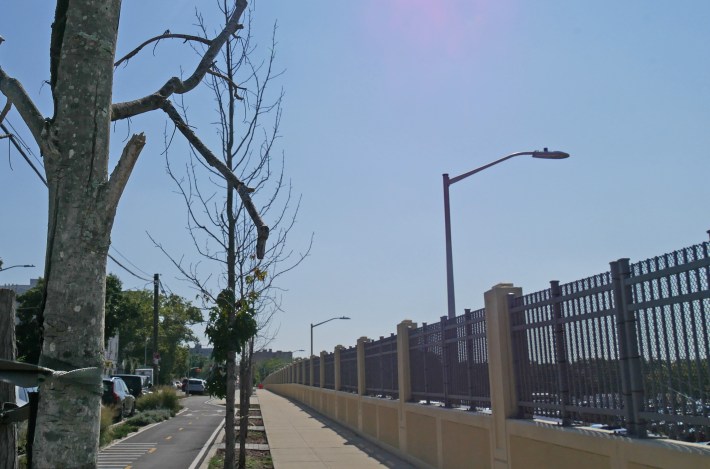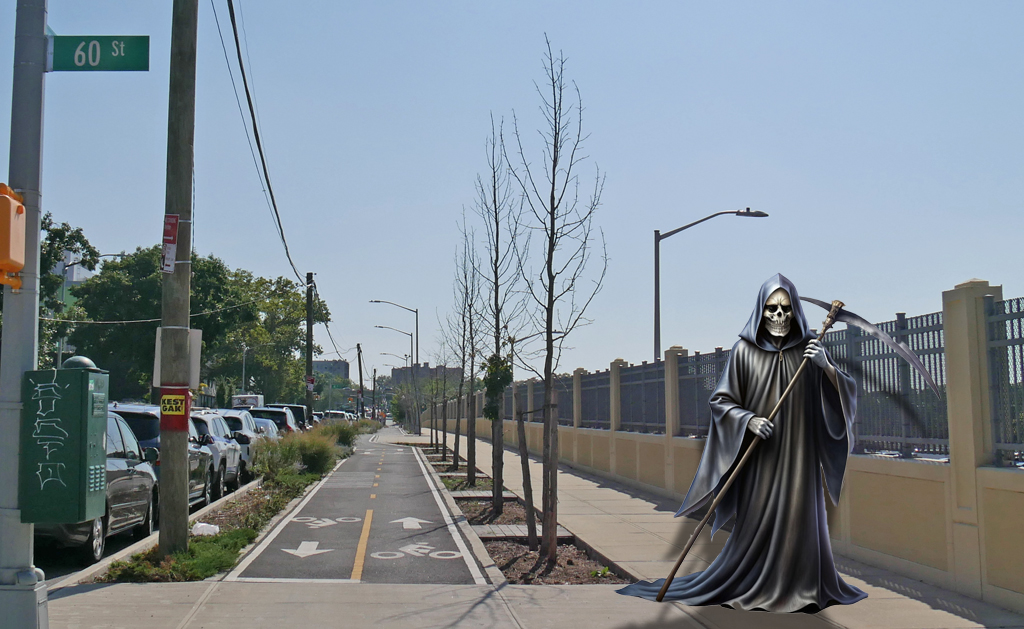Twenty-four trees were planted along Sunset Park’s greenway in 2022. Eighteen are now dead.
The stretch of Second Avenue between 58th and 65th streets was made part of the Brooklyn Greenway in 2022 and transformed from a sidewalk into a protected two-way bike lane lined with new trees. But all but six trees have died, creating a less-than-inviting greenway without shade or greenery.
Residents have called 311 and have emailed local pols and city agencies, but nothing has been done — and for locals the arborcide is less about trees than about the feeling that the city has neglected a neighborhood that has long been blighted by the Brooklyn-Queens Expressway as well as a disproportionate amount of local truck traffic and road violence.
“It's an equity issue," said Katherine Walsh, a lifelong resident of Sunset Park and the chair of the Community Board 7 Transportation Committee. "We are one of the most heavily impacted communities from environmental pollution because of the BQE, and yet we're getting a lack of engagement from the city.”

The Department of Design and Construction oversaw the drawn-out, seven-year design and construction process, and initially inked a deal with the Brooklyn Greenway Initiative to maintain the stretch as a part of the “adopt a greenway” program. But planning and construction took so long that the agreement expired in 2018 and no new plan was made.
“Without [a new] agreement, primary responsibility for the care of the trees and the landscaping falls to city government,” said Brian Hedden, the advocacy and greenway projects coordinator at Brooklyn Greenway Initiative.
A Department of Transportation representative told Streetsblog that the Parks Department is “responsible for tree maintenance at this location.” After a lengthy delay, a Parks spokesperson told Streetsblog that the agency's overworked arborists will inspect the trees and "remove any that are dead in accordance with our Tree Risk Management priorities."
Previously, the Parks Department had told the Brooklyn Greenway Initiative that the trees were out of warranty – meaning that DDC was no longer on the hook to replace them. So now, instead of caring for the six remaining living trees, the department said that it hopes to make the stretch part of a new street tree contract that is supposed to be procured by June 2025.
During the recent heat wave, another problem with the dead trees became obvious: they provide no shade.
“If the trees were alive it would be nice and shady,” said Sommer Rodriguez, one of two employees at the nearby NYU Langone medical facility that were taking a break in a sliver of shade created by a parking lot wall. “There’s definitely a lack of care over here. I don’t think the city checks on it a lot.”
Sunset Park is an “environmental justice community,” evidence of lasting health problems for the neighborhood and its residents (Walsh herself has asthma). Living trees have been proven to purify air, provide much-needed shade, and encourage people to bike, which also reduces local pollution.
“We have high rates of air quality issues and the impacts of those issues on human health, like asthma and other respiratory problems,” said Walsh. “We know that the BQE running through our community is directly linked to challenges related to pollution. Trees provide so many wonderful benefits to our community. We need to have as many trees as we can to combat these issues.”
The city is well aware of the challenge of greenway maintenance. In 2008, the Regional Plan Association and the Brooklyn Greenway Initiative rang the alarm bell in Sunset Park and specifically offered potential plans.
“The challenges are heightened by the greenway not being a part of the core mission of some agencies and, as such, it may not receive priority attention and funding on an ongoing basis,” the group's wrote at the time.
More recently, Streetsblog has covered the city's ongoing failure. Yet alarms are still sounding: Earlier this year, Mayor Adams cut the Parks Department budget by about $20 million, which hurt staffing for a number of tasks, including maintenance.
Hedden at the Brooklyn Greenway Initiative thinks the real problem lies in the city's approach to greenways, and wants to see it change so that each agency can have clear responsibilites.
"The city has a bureaucratic challenge in maintaining greenways, this relatively new piece of street infrastructure," said Hedden. "Throught the NYC Greenways Coalition, we and a number of other groups have advocated for a citywide approach where each agency is managing the thing that it's good at."






